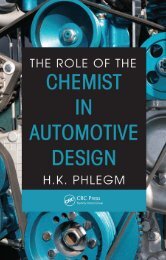Lightweight Electric/Hybrid Vehicle Design
Lightweight Electric/Hybrid Vehicle Design
Lightweight Electric/Hybrid Vehicle Design
You also want an ePaper? Increase the reach of your titles
YUMPU automatically turns print PDFs into web optimized ePapers that Google loves.
66 <strong>Lightweight</strong> <strong>Electric</strong>/<strong>Hybrid</strong> <strong>Vehicle</strong> <strong>Design</strong><br />
inductance. The magnets in this application have been fitted with a sleeve on the rotor outside<br />
diameter, for mechanical protection and to physically hold the magnets in place. A carbon-fibre<br />
sleeve was chosen for this application; it offers at least twice the strength of the steel sleeve in<br />
tension, so a much greater safety factor can be achieved. The sleeve on the rotor increases the<br />
effective air gap but an unloaded air gap flux density of 0.6 tesla was achieved from this high<br />
energy density rare earth magnet. The core loss in the stator, due to high frequency, is considered<br />
and must be kept to an acceptable level. The grade of material considerable is radiometal 4550.<br />
This alloy has a nominal 45% nickel content and combines excellent permeability with high<br />
saturation flux density.<br />
3.5.4 MAGNETIC CIRCUITS<br />
The magnetic circuit for this design was calculated using the Nelco software. The most important<br />
parameters in the design of the magnetic circuit were weight and to keep the core losses down to<br />
a minimum whilst reducing the slot leakage to minimize the winding inductance. This is achieved<br />
when a compromise has been reached in which the flux density in the teeth is 1.15 tesla, the<br />
density in the core is 0.8363 tesla, and the yoke flux density is 0.78 tesla.<br />
3.5.5 BRUSHLESS MACHINE DRIVE<br />
The machine drive consists of a polyphase, rotating field stator, a permanent magnet rotor, a<br />
rotor position sensor, and the electronic drive. During operation the electronic drive, according<br />
to the signals received from the rotor position sensor, routes the current in the stator windings to<br />
keep the stator field perpendicular to the rotor permanent field, and consequently generates a<br />
steady torque. Conceptually, the drive operates as the commutator of a DC machine where the<br />
brushes are eliminated. The main advantage here is that no current flow is needed in the rotor.<br />
As a result, rotor losses and overheating are minimal, the input power factor approaches unity<br />
and maximum efficiency is obtained. This is especially relevant in continuous duty applications,<br />
where the limiting factor of traditional induction drives is invariably the difficulty of removing<br />
rotor losses.<br />
Fig. 3.9 Machine controller.







